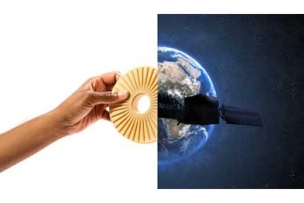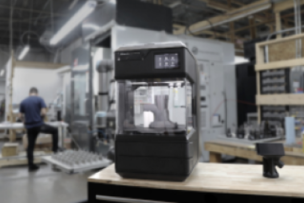ISCAR is the largest of the 15 companies comprising IMC (International Metalworking Companies). Together, they supply a dynamic comprehensive line of precision carbide metalworking tools. These companies produce a wide range of carbide inserts, carbide endmills, and cutting tools, covering most metal cutting applications. IMC also provides engineering and manufacturing solutions to major industries throughout the world. Many innovative products, designed especially for customer requirements, have made IMC a world leader in major manufacturing industries such as automotive, aerospace, and die & mold production.
The new millennium poses revolutionary solutions for metal cutting applications. ISCAR, a primary innovator of metal cutting technologies, is researching the integration of additive machining processes. Pioneering new metal cutting technologies promotes ISCAR’s prolific R&D engineers to pursue ongoing innovative solutions to decrease production costs and increase productivity for its customers.
One of the main results of the Digital Revolution (also named the 3rd Industrial Revolution) has been the introduction of 3D printing – a method that generates 3D objects with the use of evaporating material, layer by layer under computer control. Previously regarded as ‘science fiction’, over the past two decades 3D printing has become accepted as a welcome addition to designers’ and manufacturers’ range of technological facilitates.
Today, the method is known mainly as additive manufacturing (AM). This term correctly reflects two of the most important 3D printing features:
a) Manufacturing – having migrated beyond its previously recognized domain of rapid prototyping, the method is now common use in numerous industrial applications, where it is used in the production of various parts and components.
b) Additive – in direct contrast with traditional manufacturing technologies based on material removal, the new method adds material to achieve the desired component. Traditional manufacturing methods add materials during the assembly process.
There are various techniques of additive manufacturing, which are based on different physical principles: stereo lithography, multi-jet modelling and laser sintering. In accordance with active international and national standards, AM is accurately specified and divided into categories. In the eighties, 3D printing began as a design tool and a way to achieve rapid prototyping. Rather than rely on conventional 2D drawings, the use of 3D printing allowed solid, tactile prototype models to be created, enabling product specifiers to gain a greater understanding of factors such as aesthetics, functionality, weight and surface finish. The technology also delivered faster production times.
The relentless technical progress in the 3D printing process allowed its advancement into AM. At the beginning of the 21st century, the technology was adopted for serial production processes. As with all technological innovations, the popularity of AM, its increasing industrial utilization and the economies of scale brought about by rapidly growing sales, has resulted in fierce competition between AM machine manufacturers and a reduction in the price of the technology. To some, the 3D printer may still appear to be the technology of tomorrow, although in many areas, the technology is regarded as a mainstream CNC machine tool.
Additive manufacturing providing a gateway completely new horizons for producing a wide range of components such as: medicine, aerospace, automotive, naval, military; the list is endless. It is amazing that digital technologies simply erase existing boundaries: principally, it is enough to send the computer model of a component to a 3D printer, which may be situated in a remote location, and the required component will be manufactured without further manual involvement. For example, it is now possible to produce necessary spare parts on-board, during a space flight.
In addition, customized, “tailor-made” bone implants can be designed and created. It is amazing to consider, the 3D printer can be a self-reproducing machine and quickly produce its own broken part or a temporary replacement. Additive manufacturing has advantages and disadvantages; and understanding these pros and cons defines AM’s place in metal cutting.
Additive manufacturing can significantly cut production costs when producing complicated parts.
The extreme flexibility of the technology is another major advantage, for example, the same 3D printer can easily produce different parts without serious adjustments. Also, in actual rapid prototyping, if a change in the design is needed, it is quickly performed by editing the computer model of a part and further 3D “reprinting”. Consequently, AM is able to cut concept-to-delivery time dramatically or to enable changes to existing designs by producing quickly incorporated parts.
The method ensures designs that will be very close to ideal from an engineering point of view; a variable wall thickness for equal strength, a necessary channel shape for effective flow, etc. In the additive manufacturing process, using only required amounts of material noticeably reduces the amount of production wastes.
Nevertheless, AM is not free from disadvantages. When it comes to accuracy, the technology is still not fully developed for matching surfaces, and therefore finishing by traditional machining methods is often required. Not every engineering material is suitable for enabling parts to be made through the additive manufacturing method. The size of modern 3D printers has dimensional limitations for its working space and is unable to produce large components.
ISCAR’s R&D division understands the merits and demerits of AM as a base for using it in the metalworking industry. According to press and technical reports, the main sectors that have adopted 3D printing are the aerospace, military, automotive and medical industries where AM is not used for prototyping, but for batch and even large-volume production. Despite its increasing use, the new method is still far from being regarded as being a mainstream technology in global metalworking.
In the aerospace industry, although some minor parts, accessories and hardware are perfect for 3D printing, due to safety reasons (understandably, the safety requirements of this sector are extremely strict) AM produced critical parts will need to pass various, strenuous tests before being considered as replacements for components that are manufactured by more traditional methods. However, a wide variety of technological fixtures, jigs and gauges are made by AM methods. Aircraft production involves a whole complex manufacturing chain, requiring a lot of fixtures. The introduction of AM to the creation of production tooling radically reduces pre-production times and costs.
Much smaller sizes and less stringent safety standards opened doors to AM in producing unmanned air vehicles (UAV), where the new method enables not only reductions in weight, but also the shaping of these aircrafts more effectively from an aerodynamic point of view at lower costs.
Titanium is one of the most commonly used materials within the global Aerospace sector. Producing titanium parts is a real time metal-consuming process. In a typical machining process, most of this expensive and hard-to-machine material is removed.
The efforts of aircraft manufacturers are directed production of titanium powder for making relatively small titanium parts. The automotive industry has adopted AM in a similar manner as in the aerospace industry.
When applied to the production of cutting tools, 3D printing may provide solutions for several reasons. AM enables creating complex internal channels and cavities in cutting tools. These features provide a coolant supply to the cutting zone through the body of a tool. If the tool is designed for machining with high-pressure coolant (HPC), the shape of the channel and its cross-section is a key factor; and additive manufacturing provides the ideal solution for “forming” the channels. Also, additive manufacturing enables creating a cutter body that is already equipped with chip gullets, relief surfaces, back drafts and undercuts. In the use of traditional technology, these features are delivered by the application of cutting techniques. In these areas the application of AM would reduce machining operations and slash cycle time. In addition, AM ensures the formation of the required shapes with optimum balance between the body strength and chip evacuation.
When AM is developed to allow parts to be printed from cemented carbide, or form a material with similar physical properties a new threshold in cutting tool manufacturing will be achieved. ISCAR R&D engineers are adopting new working methods for creating indexable inserts without the need to incorporate expensive and time-consuming die-sets. The cycle times for testing tools and inserts will be shortened dramatically.
Although there are exciting prospects on the horizon for the application of AM in the cutting tool industry, several obstacles need to be overcome. Due to accuracy limitations, 3D printing cannot eliminate machining processes at this time. Essential attributes such as central bores for arbors or shanks require grinding, datum surfaces of an insert pocket require milling, and holes need to be threaded. It may be noted that machine tool producers already offer “hybrid” machines, which combine the traditional technology of metal removal with 3D printing. Fatigue life, repeated stress failure and reliability in high-speed rotation are subject to be examine.
ISCAR, as one of the world’s leading producers of cutting tools, has already introduced the new method in its research departments and AM is now used for prototyping in a limited way; mainly for serial production. The progress made in these areas means that the near future will tell how intense 3D printing will be adopted into the area of cutting tool production.







Talk to Us!
Leave a reply
Your email address will not be published. Required fields are marked *